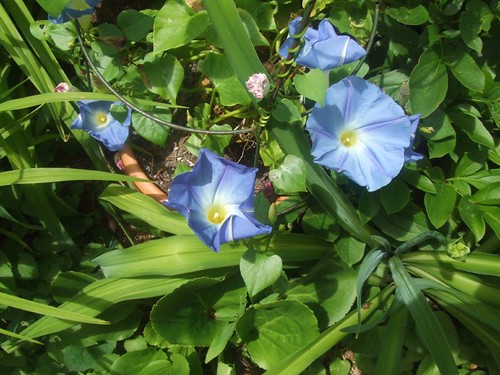Morning Glory is a common name for over 1,000 species of flowering plants in the family Convolvulaceae. These plants are well-known for their vibrant trumpet-shaped flowers that bloom in the early morning and close by the afternoon. They are often found in gardens, where they can add an alluring touch with their beautiful shades of blue, pink, purple, white, or red.
The Morning Glory vine is revered not only for its stunning appearance but also for its rapid growth. With proper care, it can easily cover a wall, trellis, or fence, providing a colorful backdrop. Its hearty nature, coupled with its minimal requirements, makes it a favored choice among gardeners.
However, some species can be invasive in certain areas, so care should be taken to manage growth and prevent unwanted spreading. The seeds of certain species also contain LSA, a substance that is considered toxic, so proper caution should be taken if children or pets are around.
| Attribute | Details |
|---|---|
| Common Names | Morning Glory |
| Botanical Name | Ipomoea |
| Family | Convolvulaceae |
| Plant Type | Annual vine |
| Mature Size | 6 to 10 feet tall |
| Sun Exposure | Full sun |
| Soil Type | Well-drained soil |
| Hardiness Zones | 3 to 10 |
| Native Area | Tropical and subtropical Americas |
Morning Glory Care
Morning Glory is a relatively low-maintenance plant, thriving in a variety of garden settings. Providing a trellis or some support will allow the vines to climb and create a beautiful vertical display. They prefer full sun and well-drained soil but are quite adaptable.
Although they’re not particularly thirsty plants, regular watering during dry periods will keep them looking their best. A balanced fertilizer can be applied sparingly, as too much can lead to more leaves and fewer flowers.
Light Requirement for Morning Glory
Morning Glory vines thrive in full sun. They need at least 6 to 8 hours of direct sunlight to bloom profusely. Lack of sufficient sunlight may lead to reduced flowering and weaker growth.
Soil Requirements for Morning Glory
Well-drained soil is preferred, but Morning Glories are adaptable and can tolerate various soil types, including sandy, loamy, or clay soils. They are not very particular about soil pH either.
Water Requirements for Morning Glory
Water Morning Glories regularly but not excessively. While they can tolerate drought, consistent moisture, especially during dry spells, will promote healthy growth and blooming.
Temperature and Humidity
Morning Glories are best grown in temperatures between 65-85°F (18-30°C). They can withstand higher temperatures but may suffer in prolonged cold. Humidity doesn’t significantly affect their growth.
Fertilizer
Use a balanced fertilizer sparingly, as excessive feeding can lead to vigorous growth of leaves at the expense of flowers. A slow-release granular fertilizer applied in the early growing season can be beneficial.
Pruning Morning Glory
Pruning is necessary if the vines become too dense or spread beyond the desired area. Cut back as needed to maintain shape and encourage air circulation, which helps prevent diseases.
Propagating Morning Glory
Propagation can be done through cuttings or seeds. Cuttings should be taken in late spring, whereas seeds can be sown directly into the garden after the danger of frost has passed.
How To Grow Morning Glory From Seed
Soaking seeds overnight or nicking them will improve germination. Plant seeds ¼ inch deep in well-drained soil, spaced about 6 inches apart. Keep soil moist until seedlings are established.
Common Pests & Plant Diseases
Aphids
These can be treated with insecticidal soap or neem oil.
Rust
This fungal disease can be controlled through pruning and fungicides.
Common Problems With Morning Glory
Lack of Blooms
Insufficient sunlight or over-fertilizing may cause a lack of flowers.
Invasive Growth
Some species can become invasive; monitor growth and prune as needed.
Pro Tips
- Provide support like a trellis or fence for the vines to climb.
- Be mindful of the potential invasiveness and choose species accordingly.
- Soak seeds overnight to aid in germination.
- Plant in full sun to ensure vibrant blooms.
- Monitor growth and prune as needed to control spread.




